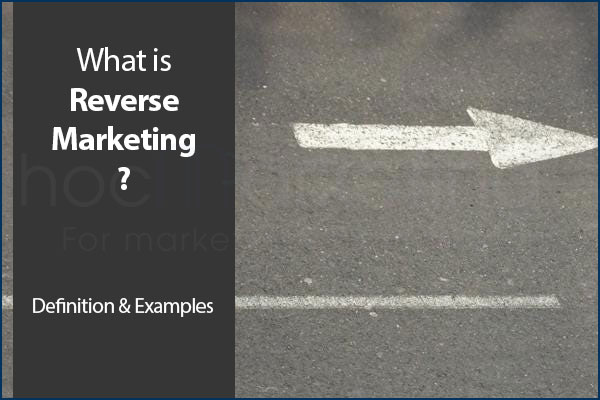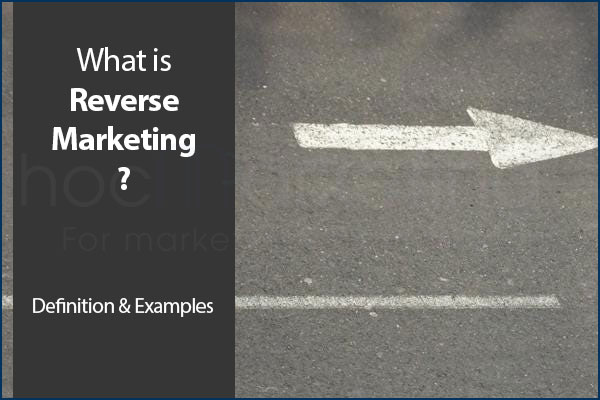
What is Reverse Marketing? Examples of Reverse Marketing

Reverse marketing is a new and innovative form of marketing that aims to promote a company's product or service by leveraging the efforts of their competitors. Find out what Reverse Marketing is, why it's so effective and the list of success stories it has generated in this article.
There are many benefits to marketing your business: whether you're a mom and pop store or a multinational one. From improving the customer experience to boosting sales, an effective marketing strategy has proved essential for businesses of all types.
All of this work to market your product or service can cost a lot of money. However, it's worth it because marketing is one of the most effective ways to sell your business.
Marketing can be tough, but thankfully there are all sorts of marketing strategies up for the job. Reverse Marketing is one such strategy that's becoming increasingly popular among businesses. Tom Fishburne said "the best marketing does not feel like marketing at all" and that might have been because he was referring to Reverse Marketing.
What is Reverse Marketing?
Reverse marketing is when the customer actively seeks out a firm for their product instead of the firm seeking out the customer. In theory, it's similar to reverse psychology in that you can get someone to say or do something by telling them the opposite of what you want.
Unlike traditional marketing methods that rely on advertising and proactive selling, reverse marketing lets end consumers find a product or service themselves. Traditional marketing, also called coercive marketing, relies on businesses to find their specific target market and then convince them to buy their product or service.
In reverse marketing, businesses give information about their products and services to consumers for free. This provides the potential customers with advice and helps them weigh their options. For example, Reverse Marketing is primarily focused on building customer loyalty and creating brand value--both of these are important features of this kind of marketing.
Advantages of Reverse Marketing
Here are four advantages of reverse marketing:
Builds trust
Reverse marketing helps build trust with potential customers by providing them with valuable information, answering their questions, and demonstrating your expertise in your industry. This can lead to a stronger relationship with your customers, who will see you as a valuable resource and trusted authority in your field.
Cost-effective
Reverse marketing is often more cost-effective than traditional marketing methods like cold calling or direct mail campaigns. By creating valuable content that attracts potential customers, you can reduce the need for expensive advertising campaigns and other outbound marketing techniques.
Increases brand awareness
By creating valuable content and optimizing it for search engines, you can increase your brand's visibility and reach a wider audience. This can help you build brand awareness and establish yourself as a thought leader in your industry.
Higher conversion rates
Because reverse marketing focuses on attracting customers who are already interested in your products or services, your conversion rates are likely to be higher. This means that you'll be able to convert more leads into paying customers, which can ultimately lead to increased revenue and growth for your business.
Disadvantages of Reverse Marketing
While reverse marketing has many advantages, there are also some potential disadvantages that businesses should consider. Here are four possible drawbacks of reverse marketing:
Takes time to see results
Reverse marketing is a long-term strategy that can take time to see results. It requires consistent effort in creating valuable content, optimizing it for search engines, and building relationships with potential customers. It may take several months or even years to see a significant increase in traffic and conversions.
Requires specialized skills
Reverse marketing involves creating high-quality content that resonates with your target audience and is optimized for search engines. This requires specialized skills like content creation, search engine optimization (SEO), and social media marketing. If you don't have these skills in-house, you may need to hire external experts, which can be costly.
Risk of attracting the wrong audience
Reverse marketing can attract a broad audience, some of whom may not be a good fit for your products or services. This can result in wasted time and resources trying to market to people who aren't likely to convert into paying customers. It's important to carefully target your content and messaging to attract the right audience.
May not work for all industries
Reverse marketing is best suited for industries where potential customers actively search for information and solutions. For example, it may work well for software companies or financial services firms, but may not be as effective for industries like construction or manufacturing, where customers are less likely to search online for information about products and services.
Examples of Reverse Marketing
The Patagonia Jacket's "Don't Buy This" campaign
Reverse marketing can be very successful when implemented carefully. A recent example is the Patagonia Jacket's "Don't Buy This" campaign, which sparked a 29% increase in sales.
Patagonia was committed to environmental and economic sustainability, and it showed in their marketing campaign. In a specific campaign, they launched "Don't Buy This" ads on Black Friday when their target audience would be most engaged. The ad encouraged customers to think about what they were purchasing before making every purchase and spurred conversation about mindless consumption of things we don't need.
Though Patagonia wasn't telling buyers to not buy their products, this campaign showed Patagonia as a company who is environmentally aware and sustainable which resonated with Patagonia's customer base and increased sales.
Dove Campaign for Real Beauty
A popular example of reverse marketing is the Dove Campaign for Real Beauty. In this campaign, Dove's competitors were emphasizing the flaws of their consumers and how their products could cover up or improve those flaws. Dove, on the other hand, focused on the natural beauty of its consumers and celebrated common women's beauty- rather than promoting its product. Using real women in their campaign, Dove was able to generate sales of more than $1 billion because of this one campaign.
Swati Spentose
The Swati Foundation is a perfect example of a small business opting for Reverse Marketing. The foundation seeks to support people who suffer from neglected diseases like Bone Disorder, Kidney Inflammation, Alzheimer and Urological Disorders. This is the perfect way to show what Reverse Marketing can do for your business!
A pharmaceutical company, the message is that it's committed to delivering true health and wellness to its end consumers.
Aviva India
Aviva India, an insurance company, is an example of Reverse Marketing that's been successful. This company tells its consumers that they are leading a happy life and then asks them to make it even better by learning and trying new things. These advertisements are motivating enough to convince people to choose Aviva over other competitors.
Why does Reverse Marketing work?
As adults, it's important to listen to our own instincts. This is hard, because there are so many distractions in the world. Many people try to compel you to do something with their words or actions. If this compulsive behavior continues unchecked, your subconscious mind will start to resist what others say and do. Soon enough, it may be doing the opposite just because it has internalized that idea.
Commercials that scare consumers into buying certain products are called “threat strategy” commercials. For instance, an advertisement might tell a consumer that their car engine will develop a snag if they do not use a particular additive. This scares the consumer and forces them to buy the additive from that one company instead of from competitors. However, reverse marketing means moving away from this “threat strategy” and striking a chord with consumers by offering what’s best for them.
How to create an effective Reverse marketing campaign?
Reverse Marketing is not as easy as it looks and requires a lot of work. There are many things to keep in mind while thinking and creating a campaign:
- Step back to evaluate your business's current image and the target groups you want to appeal to. Identify what is important for the appropriate demographic and why they should care about your company.
- Once you understand how our requirements can best serve your needs, tell them what your product or service is about.
- Persuade your consumer to close the sale but don't stop there. Let them know you want to help their business too; offer them something of value for giving you their email address or phone number.
Conclusion
When you're a new business, you want the best chance of success. For that to happen, you'll want to stay away from Reverse Marketing. statistics have shown that only established brands have been able to leverage it and do so successfully.












